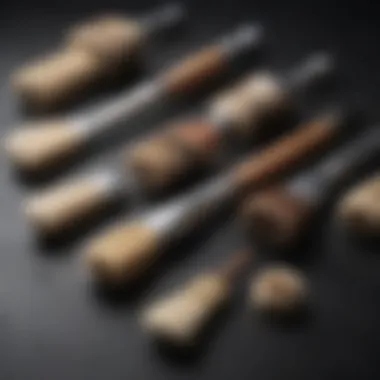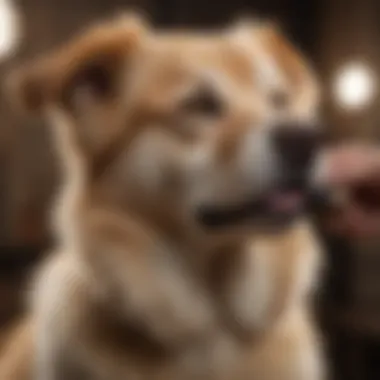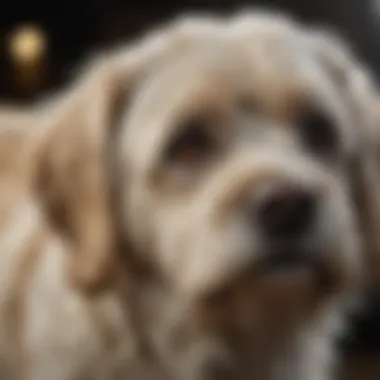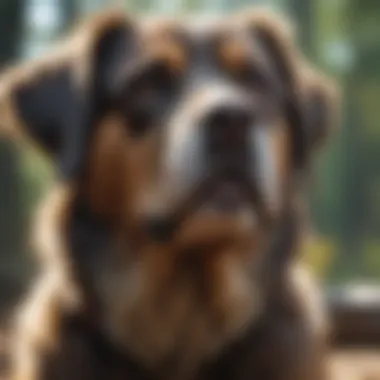The Best Undercoat Dog Brush: A Comprehensive Guide


Intro
Undercoat brushing is an often overlooked but crucial part of dog grooming. Many dog owners may not fully grasp the significance of regularly removing undercoat fur. While surface brushing may seem sufficient, this can actually lead to matting and skin problems in many breeds. Understanding the necessity of the right tools is essential for maintaining a dog's health and appearance.
Selecting the best undercoat dog brush is influenced by several factors. These include the breed's coat type, size, and individual grooming needs. This article will guide you through the key aspects of undercoat grooming, outlining different brush types and their specific uses. Additionally, it will highlight the benefits of proper brushing, ensuring that both the owner and their canine companion enjoy an effective grooming experience.
With various brushes on the market, making the right choice can seem daunting. However, this guide will break down each component clearly, ensuring you can make an informed selection for your loyal pet.
Understanding Undercoats in Dogs
Understanding the concept of undercoats in dogs is crucial for any pet owner. An undercoat serves multiple purposes; it is not just fluff. An effective undercoat can regulate a dog's body temperature and protect their skin from environmental factors. It is a layer that often requires special attention during grooming. Neglecting a dog's undercoat may lead to skin issues and discomfort for the animal. Therefore, being informed about undercoats can significantly influence the dog's well-being and grooming routine.
What is an Undercoat?
An undercoat is a dense, soft layer of fur found beneath the top coat of a dog's fur. This undercoat usually consists of shorter, finer hairs, and its primary function is to provide insulation. In colder weather, the undercoat helps retain body heat, while in warmer weather, it can assist in cooling the dog down by trapping air. Various breeds possess different types of undercoats, which can vary significantly in density and texture. For example, breeds like the Siberian Husky or Golden Retriever possess a thick undercoat, while others may have a lighter version. Recognizing the structure and function of an undercoat is essential when selecting grooming tools, particularly brushes designed to handle shedding and matting.
The Role of Undercoats in Dog Health
The health of a dog is often reflected in the condition of its undercoat. Good undercoat management contributes to a dog's overall health. Here are some key aspects to consider:
- Temperature Regulation: A well-maintained undercoat aids in temperature control. Dogs that live in varying climates can particularly benefit from effective undercoat care.
- Skin Health: Undercoats can trap dirt, debris, and moisture. Regular brushing helps remove these particles, reducing the chance of skin infections.
- Allergy Management: Keeping the undercoat clean helps reduce allergens that can affect both dogs and humans in the household. This is important for families with allergy concerns.
- Reducing Shedding: A proper grooming routine can lessen the amount of loose fur around the home.
"Regular grooming does not just improve the appearance of dogs; it also enhances their overall health and comfort."
The Necessity of Undercoat Brushing
Undercoat brushing is an essential aspect of dog care, particularly for breeds with dense fur. The structure of the undercoat serves several fundamental functions. By understanding the necessity of undercoat brushing, pet owners can improve their dog’s comfort and overall health. It is not simply a grooming task; it is an important maintenance routine that protects and preserves the animal's well-being.
Benefits of Regular Undercoat Brushing
Regular undercoat brushing provides numerous advantages for both the dog and its owner. First, it helps to reduce shedding significantly. Loose hair is often a source of frustration in homes with pets. Brushing allows the owner to control the amount of shedding spread throughout the living space. It keeps the house cleaner, which can be a relief for those with allergies.
Second, effective brushing promotes healthy skin and fur. Brushing removes dead hair and dander, which prevents matting and tangles. This is crucial for keeping the fur manageable. Healthy fur reflects good nutrition and proper care. Furthermore, brushing stimulates the skin’s natural oils, resulting in a shinier coat. A clean and well-maintained undercoat protects against skin irritations and infections.
Lastly, brushing can build a stronger bond between the pet and the owner. During brushing sessions, the dog receives attention and care. This mutual interaction fosters trust and affection.
Frequency of Undercoat Brushing
Determining the frequency of undercoat brushing largely depends on the breed and coat type of the dog. For breeds with thick undercoats, like Golden Retrievers, brushing is required at least two to three times a week. In shedding seasons, these dogs may need daily brushing to manage excessive fur loss effectively. On the other hand, dogs with short coats, like Beagles, may require less frequent brushing, perhaps once a week.
Regardless of the dog's coat type, seasonal changes can influence the shedding pattern. For instance, many dogs shed heavily in spring and fall. During these times, owners should increase the brushing frequency.
It is also vital to consider the temperament of the dog when establishing a brushing routine. Some dogs may feel uncomfortable during brushing for extended periods. Owners should be mindful of their dogs’ reactions and adjust the frequency and duration accordingly. Regular brushing sessions in a calm and familiar environment yield the best results.
Types of Undercoat Brushes
Understanding the different types of undercoat brushes is key for effective grooming. Each type of brush serves a specific purpose in undercoat care. Choosing the right one can make the grooming process more efficient and improve your dog’s coat health. In this section, we delve into various brushes used for managing undercoats, discussing their unique features and benefits.
Pin Brushes


Pin brushes are often used for long-haired breeds. These brushes feature widely spaced pins, which help remove loose hair and prevent mats. The rounded tips of the pins offer a gentle touch against your dog’s skin. This ensures comfort while grooming. When using pin brushes, it's important to work in sections to fully remove loose undercoat. This method helps avoid causing any discomfort to your pet.
Slicker Brushes
Slicker brushes are highly effective for removing mats and tangles. They consist of fine, short wires close together. This design allows them to penetrate the thickest coats, effectively catching loose fur and debris. Slicker brushes work well on both long and short-haired breeds. However, the key is to use them with care. Avoid pressing too hard against your dog's skin to prevent irritation. Regular use of slicker brushes can significantly reduce shedding in homes with dogs that have a dense undercoat.
Undercoat Rakes
Undercoat rakes are specialized tools designed specifically for thick undercoats. They come with long, sharp teeth that penetrate the top layer of fur. This allows for easy removal of the loose, dead undercoat underneath. Owners of double-coated breeds will find undercoat rakes particularly beneficial. When using this type of brush, it's advisable to brush in the direction of hair growth to prevent any discomfort. Regular use can improve airflow to the skin, promoting better overall health.
Bristle Brushes
Bristle brushes are often overlooked but can serve a valuable role in grooming. They feature soft bristles that are gentle on the skin. These brushes work well for smoothing the coat and distributing natural oils. While they are less effective at removing loose hair, they can help maintain a healthy, shiny coat. Bristle brushes are ideal for short-haired breeds, where shine and texture are important. Consider them a finishing tool in your grooming routine for added shine and softness.
In summary, knowing the types of undercoat brushes along with their specific functions is vital for proper grooming. The right brush can enhance your dog’s comfort during grooming sessions and contribute to a healthier coat.
How to Choose the Right Undercoat Brush
Choosing the right undercoat brush for your dog is crucial for effective grooming and overall health. The right brush can make the task easier and more pleasant for both you and your pet. Selecting the appropriate tool requires a keen understanding of several factors, such as your dog’s unique coat characteristics, breed specifics, and the materials used in the brush itself. Understanding these elements ensures that the brush you select will cater to your dog's specific needs and will help maintain a healthy undercoat.
Assessing Your Dog’s Coat Type
Assessing your dog's coat type is the first step in choosing an undercoat brush. Dogs can have various coat types, including short, long, curly, or wiry. Each type requires different brushing tools for optimal care. For instance, dogs with a double coat, such as a Siberian Husky, benefit from rakes and slicker brushes, which can effectively remove loose undercoat fur.
In contrast, breeds like Beagles may do well with pin brushes due to their single coat structure. Observing your dog's fur can help you identify which brush will be most effective. Look for mats, tangles, or loose hair, as these signs indicate the need for particular brushing tools. The right assessment is critical for choosing a brush that promotes healthy fur growth and minimizes shedding.
Considering Dog Size and Breed
The size and breed of your dog should never be overlooked when selecting an undercoat brush. Larger breeds typically have bigger coats and may need wider brushes to effectively cover more surface area. For smaller dogs, a compact brush can adequately reach all parts of the body without causing discomfort.
Additionally, some breeds have unique grooming requirements. Breeds like Cocker Spaniels have longer fur that may need more specialized brushes to achieve a proper grooming routine, while breeds like Bulldogs have less fur and may not require as intensive brushing. Always consider the specific grooming needs associated with your dog’s breed to ensure you select the right brush.
Material and Comfort of the Brush
The material and comfort of the brush are also significant factors. Brushes made of sturdy materials like stainless steel often last longer and can be more efficient at removing loose fur compared to those made of plastic. Furthermore, the bristles should be soft enough to avoid irritating your dog's skin. Brushes with rubberized handles provide better grip and comfort during grooming sessions.
When selecting a brush, consider how it feels in your hand. A comfortable grip can make the task of brushing more enjoyable for both you and your dog. A well-made brush will not only last but will also minimize stress during the grooming process.
"Selecting the right brush aligns with your dog's grooming needs, leading to improved coat health and bonding time."
Top Recommendations for Undercoat Brushes
Choosing the right undercoat brush is vital for effective grooming. This section aims to provide specific recommendations that cater to different breeds and budgets. Understanding the unique needs of each dog will ensure that both pet owners and their furry companions benefit from a productive grooming experience. In this guide, we will consider various criteria such as brush type, breed characteristics, and price range.
Best for Long-Haired Breeds
Long-haired breeds often require more specialized grooming tools. These dogs not only have undercoats that need attention but also the outer coat demands care to prevent tangles and mats. The FURminator Undercoat deShedding Tool stands out; it effectively removes loose undercoat hair while minimizing the risk of damage to the outer layer. Regular use can enhance coat health and reduce shedding within the home.
When selecting a brush for long-haired breeds, consider the size of the tool in relation to the dog. A larger head can cover more area quickly, while a softer bristle can help to smooth the outer coat.


Best for Short-Haired Breeds
Short-haired breeds generally require less intensive grooming. However, this does not mean they should be neglected. The Hertzko Self Cleaning Slicker Brush is an excellent choice; it can remove dead hair and promote a healthy shine. The self-cleaning feature helps keep maintenance low, which is a notable advantage for busy pet owners. Short-haired breeds can still experience issues like seasonal shedding, making regular brushing important for their overall skin health.
In addition, a rubber brush, such as the Petio Rubber Grooming Brush, can be very effective in removing dirt and dander while being gentle on the skin. These brushes provide a massaging sensation that can be enjoyable for many dogs.
Budget-Friendly Options
Affordability plays a significant role in purchasing decisions. The Pet Neat Pet Grooming Brush offers a good balance between quality and price. This undercoat rake can remove loose hair and tangles with relative ease. It is crucial to ensure that budget choices still meet the basic grooming needs without sacrificing effectiveness.
Searching for budget options does not mean compromising on results. Always read reviews and check product specifications to ascertain the brush's functionality and suitability for your dog’s coat.
Professional-Grade Brushes
For those willing to invest more, professional-grade brushes can take grooming to the next level. The Chris Christensen Big G Slicker Brush is renowned for its durability and performance. It enables efficient brushing for various coat types. Professional brushes often have ergonomic designs, which help in reducing fatigue during frequent grooming sessions.
These tools are often made from superior materials. Their effectiveness can save time and lead to better results, especially for groomers who work with multiple dogs. An investment in a professional-grade brush can significantly enhance the grooming experience, providing long-term benefits for both pet and owner.
"Investing in the right grooming tools not only improves the health of your dog’s coat but also strengthens the bond between pet and owner through a calming grooming routine."
Best Practices for Undercoat Brushing
Brushing a dog’s undercoat is crucial for maintaining its overall health and well-being. The practice of undercoat brushing should not be a mere routine task; it is an essential grooming process that can enhance the comfort and appearance of your dog. Understanding the best practices ensures that brushing can be an enjoyable experience both for you and your dog while preventing issues such as matting and excessive shedding. A well-maintained undercoat promotes proper air circulation and skin health, preventing common skin issues caused by dirt and debris.
Techniques for Effective Brushing
When it comes to undercoat brushing, using the right techniques is vital. Here are several important techniques to follow:
- Start Slowly: Begin brushing on a small area, allowing the dog to get used to the sensation. This can help the dog become accustomed to the process and reduce anxiety.
- Use the Right Technique: For undercoats, it's essential to brush against the hair growth to remove loose fur effectively. Depending on the type of brush you are using, apply gentle pressure without pulling too hard on the skin.
- Work in Sections: Divide the coat into manageable sections. Focus on one section at a time to ensure that every part of the undercoat receives attention. This approach prevents missing clumps of fur and ensures thorough grooming.
- Be Mindful of Sensitive Areas: Regions like the abdomen and tail can be sensitive. Use soft strokes in these areas to avoid causing discomfort. Always observe your dog for signs that it may be in pain or uncomfortable.
- Encourage Positive Reinforcement: Offer treats or praise after brushing sessions. This practice creates a positive association with grooming, making future sessions more pleasant for both of you.
"Regular brushing not only improves coat health but can also strengthen the bond between you and your dog."
Timing and Environment
Choosing the right time and environment for grooming plays a significant role in making undercoat brushing more effective. Here are some considerations:
- Choose an Appropriate Time: The best time to brush is when your dog is calm and relaxed. Avoid times when your dog might be hyperactive or tired. A post-walk routine often works best, as the dog is likely to be calmer.
- Comfortable Environment: Select a quiet spot with minimal distractions. An area that feels safe will help your dog relax during the grooming process. A familiar space can ease anxiety, encouraging your dog to enjoy this bonding time.
- Plan for the Weather: If it is hot or humid, make sure the environment is cool, as prolonged exposure can make your dog uncomfortable. Conversely, think about humidity and risk of debris in outdoor settings during specific seasons.
- Utilize Proper Equipment: Make certain you have all necessary tools at hand before starting. This includes a suitable undercoat brush, scissors for detangling, and a vacuum for cleaning up loose fur afterward.
Following these best practices will ensure that your undercoat brushing becomes a regular, effective part of your dog’s grooming routine. By addressing both techniques and environmental factors, you can create a more comfortable experience for your dog while maintaining its coat health.
Common Mistakes to Avoid when Brushing
Brushing a dog's undercoat is not simply a routine chore; it is essential for their overall health and wellbeing. However, many pet owners make critical mistakes during the brushing process that can lead to discomfort for the dog or increase grooming time unnecessarily. Understanding these common pitfalls can enhance the effectiveness of grooming sessions and foster a stronger bond between pet and owner.
Using Incorrect Tools
Selecting the proper tools is foundational for effective undercoat grooming. Using brushes that are not suited for a dog's specific coat type can cause more harm than good. For instance, a slicker brush may be necessary for a long-haired breed, but using a bristle brush could lead to irritation and result in damage to the hair shafts. On the other hand, a pin brush works well for certain coat types but may not effectively remove loose fur from a double coat.
Owners often underestimate the importance of the right brush, resulting in ineffective grooming. It is crucial to familiarize oneself with the specific needs of their dog's coat. An example of an effective tool is the Furminator Undercoat Deshedding Tool, which is designed for double coats and reduces shedding significantly.


Furthermore, using worn or damaged brushes can add to discomfort for the dog. It's essential to check the condition of the bristles and ensure they are clean and intact.
Brushing Too Hard
Another frequent mistake is brushing too hard or aggressively. This can not only cause pain but also create a negative association with grooming. Dogs have sensitive skin; even a gentle tug can lead to discomfort. Therefore, using a light hand when brushing is vital.
It can be beneficial to gauge the dog's reaction during the brushing process. If a dog pulls away or seems anxious, it may indicate that brushing too hard is a problem. Instead, the goal should be to brush lightly while still effectively reaching the undercoat.
Additionally, brushing should be a calming experience rather than a battle. Forcing the brush through tangles without a proper detangling technique can result in breakage and discomfort.
Here are some tips to ensure gentle brushing:
- Use short and soft strokes.
- Take breaks if the dog appears to be uncomfortable.
- Always reward your dog post-grooming to create positive reinforcement.
"Grooming sessions should aim to be a bonding time, not a chore."
By avoiding these common mistakes when brushing, pet owners can promote better hygiene, reduce shedding, and improve their dog’s overall attitude towards grooming.
Maintaining Your Undercoat Brush
Proper maintenance of your undercoat brush is crucial for various reasons. First, a clean brush improves the efficiency of grooming. If the bristles are clogged with hair, dirt, or debris, the brush will not work effectively. This can make grooming uncomfortable for your dog and can even lead to skin issues. Additionally, maintaining your brush helps to prolong its lifespan. A well-cared-for brush does not need to be replaced as frequently, saving you money in the long run.
Another key factor is hygiene. Grooming tools can harbor bacteria, particularly if they are not cleaned regularly. This poses a risk to your dog’s health. Regular cleaning ensures that the brushes contribute positively to grooming and do not introduce complications.
In summary, maintaining your undercoat brush optimizes grooming effectiveness, extends tool lifespan, and promotes good hygiene for your pet.
Cleaning and Caring for Brushes
To ensure your undercoat brush remains in top condition, start with regular cleaning. After each use, remove any hair that has accumulated in the bristles. You can do this by using your fingers or a comb specially designed for this purpose. For a more thorough clean, wash the brush with a mixture of warm water and a mild soap. Avoid harsh chemicals, as these could damage the materials or irritate your dog’s skin during grooming.
Let the brush air dry completely before using it again. This prevents moisture from being trapped, which can lead to mold and bacteria growth. Additionally, inspecting your brush weekly or bi-weekly will help you identify any wear or damage early on.
When to Replace Your Brush
Knowing when to replace your undercoat brush is essential for maintaining grooming efficiency. Look for signs of wear, such as bent or broken bristles, which reduce the effectiveness of brushing. If the handle feels loose or uncomfortable, it may also be a sign it’s time for a new tool.
Consider replacing the brush every 6 to 12 months, or sooner if significantly damaged. However, if you notice that despite cleaning, the brush isn’t working well or causes discomfort, it’s better to invest in a new one. Always prioritize your dog’s comfort, as using an ineffective or old brush can lead to a negative grooming experience.
Regular maintenance of your undercoat brush improves grooming efficiency, hygiene, and dog comfort.
By staying aware of the condition of your grooming tools, you not only enhance your experience but also ensure your pet's health and well-being.
Culmination
The conclusion serves as an integral part of this guide, bringing together the important elements discussed. It offers a reflection on the entire discourse surrounding undercoat brushes and their significance in the life of a dog owner. Understanding the best undercoat brush involves recognizing the needs specific to different breeds and coat types. By following proper brushing techniques and regularly maintaining grooming tools, pet owners can enhance their dog's overall health and well-being.
In essence, undercoat brushing not only minimizes shedding but also promotes a healthy skin environment. Proper brushing techniques can prevent matting, which can lead to skin problems if untreated. Adopting the right brush type and following care tips ensures effective and sustainable grooming. This is paramount in fostering a strong bond between the pet and owner, as grooming time can turn into a shared experience that boosts mutual trust and comfort.
Recap of Key Points
- Understanding Undercoats: Knowing what an undercoat is and its role in dog health establishes the foundation of proper grooming.
- Types of Brushes: Familiarity with various brush types - pin brushes, slicker brushes, undercoat rakes, and bristle brushes - guides owners in making informed choices.
- Choosing the Right Brush: Factors like coat type, breed size, and comfort significantly affect brush selection.
- Benefits of Brushing: Regular undercoat brushing promotes better coat health, reduced shedding and contributes to a more enjoyable grooming experience.
- Maintaining Brushes: Cleaning and timely replacement of grooming tools ensures they perform optimally and stay hygienic.
Final Thoughts on Undercoat Brushes
In summary, undercoat brushes are essential tools in the canine grooming arsenal. They not only improve the quality of the dog's coat but also address underlying health issues that may arise with poor coat maintenance. Investing time and resources into the right brushing practices reflects the pet owner's commitment to their animal's well-being. By being diligent in their grooming routine, owners can ensure a happier and healthier pet. Knowledge gained from this guide can lead to informed decisions that enhance the grooming experience, voila! The right brush not only benefits your dog but also enriches the bond you share.
"A well-groomed dog is a happy dog."







